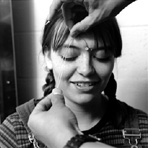
Fall 1998
![]()
Covering black holes, fossil worms, and a cure for cancer
![]()
![]()
Soundings is a publication of the School of Humanities and Social Science at MIT
Comments and questions to www-shss@mit.edu
Speech is a river of breath, bent into hisses and hums by the soft flesh of the mouth and throat.
Stephen Pinker, The Language Instinct
What's in a word
 What
happens when you say "cat"?
What
happens when you say "cat"?
Perhaps what's conjured is a furry, four-legged creature with a tail that often visits a litter box and sometimes catches mice and birds. If you're in a poetic frame of mind, perhaps a slew of other words that rhyme - bat, hat, sat, and fat - appear in your mental Rolodex. But if you're a linguist - more specifically, if you're Professor Alec Marantz in the Linguistics and Philosophy Department - what happens when you say "cat" is a question whose answer captivates at a totally different order of understanding and cognition.
Marantz and his colleagues are looking into the human brain to decipher how language works there. He's exploring the activity that occurs in the brain, and where in the brain it is occurring when you hear a word such as cat - or smaller parts of it like "kæ" or "æ". Is that activity different or similar to what occurs in the brain when it perceives sounds similar to, but not, language? In other words, is the brain's response to language - to potentially meaningful sound - the same as its response to noise, or non-speech sound? "Physically, musical tones are very similar to vowels," Marantz elaborates, "so how does your brain know it's hearing language and not music? And what does that mean for the brain: what sorts of computations are triggered in its language mode?"
Marantz and his team are pursuing these questions with the aid of a cutting-edge technology. MEG - magnetoencephalography - is an emerging imaging system that detects minute magnetic fields and gives fabulously precise information about the brain's electrophysiology. Unlike other brain-imaging technologies, such as positron emission tomography (PET) and functional magnetic resonance imaging (fMRI), MEG is a completely passive, noninvasive "microscope" on brain activity and poses absolutely no risk to the people whose brains are being scanned. The MEG system is currently being used in a few dozen medical settings worldwide to create pre-surgical brain maps and assess brain trauma, epileptic activity, and other brain pathologies.
Nowhere else on the planet, however, is MEG being used by an academic linguistics department to investigate language and its neuronal expression in the brain. The $2-million-plus system, housed in a magnetically shielded room, was built and installed at MIT by the Kanazawa Institute of Technology (KIT) of Japan, with whom the MIT Linguistics and Philosophy Department has established a joint research venture.
Using the MEG system, Marantz is running a series of experiments geared toward adding critical empirical data to linguistic theorizing, thus enriching the theories themselves. One of these theories posits that just as a sentence has an intricate internal structure that follows innate rules, so does a word. When people put together sentences, they are following precise rules of mental grammar, and in the process are performing complex computational operations, albeit effortlessly. A similar mechanism occurs when uttering a single word, says Marantz. "The word 'cat' is not simple," he explains. "Even hearing the word 'cat' requires many combinatory operations in the mind." Suggesting that the mental operation involved in combining the many units of a sentence is the same as the mental operation involved in constructing a word, Marantz is looking to MEG to demonstrate this in brain waves. "We would see the same pattern of brain activity within a word as within a sentence, though more compressed in time," he says. Embedded in the pursuit is the hope that answers to "What happens when you say cat?" will ultimately shed light on the relationship between language and thought and lend insight into how humans differ from animals - cats included.
![]()
Copyright © 2000 Massachusetts
Institute of Technology